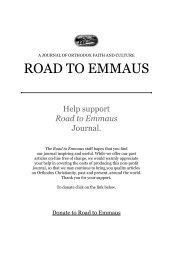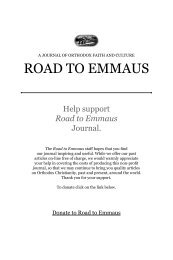RTE No 20 Interior - Road to Emmaus Journal
RTE No 20 Interior - Road to Emmaus Journal
RTE No 20 Interior - Road to Emmaus Journal
You also want an ePaper? Increase the reach of your titles
YUMPU automatically turns print PDFs into web optimized ePapers that Google loves.
<strong>Road</strong> <strong>to</strong> <strong>Emmaus</strong> Vol. VIII, <strong>No</strong>. 4 (#31)FAITH UNSEENAfter years of expectation, the tragic conclusion of the trial and the collapseof all their hopes was more than Mullah Molasleyman could bear.Crying “Water, water!” he dropped <strong>to</strong> the floor dead. He died without seeingthe fulfillment of his life’s dream – <strong>to</strong> serve openly in a church beforeGod and man.The metropolitan, who was immediately notified, sent a priest <strong>to</strong> performthe Christian funeral in the home of the mullah’s brother in Kemerkaya, inthe presence of his relatives. Meanwhile, the public “Muslim” funeral wasbeing prepared in Molos, with the hot water bath administered by thoseespecially appointed in the Muslim community. Because he was publiclyknown as a Muslim mullah, they held the Muslim service in the mosque,which was attended by many Muslims and officiated over by a mullah. Hewas buried in the Muslim cemetery.With the news of the Armenian’s hanging and the sudden death of MullahMolasleyman, the Christian community froze. Even the enthusiasts nolonger spoke of revealing themselves. Late in the same summer, OsmanPasha himself reposed, and it was generally believed that his signature condemningthe Armenian was <strong>to</strong>o heavy for his soul and had killed him. Withthe Armenian’s death, Turkish extremism declined and even the Muslimcommunity began criticizing the lack of religious freedom.The cryp<strong>to</strong>-Christians visited the Muslim cemetery for many years, quietlywhispering memorial services and praying at the graves of MullahMolasleyman and their other relatives. Later, after they revealed theirChristianity, this was no longer allowed, as the Muslims did not want them<strong>to</strong> pray Christian prayers over the graves of their “Muslim” ances<strong>to</strong>rs.If you go <strong>to</strong> Turkey now, you may enter a Mohammedan cemetery even ifyou are not Muslim. At that time, however, if you were openly Christian (orlater, when it was safe for the cryp<strong>to</strong>-Christians <strong>to</strong> reveal themselves) youwere not allowed <strong>to</strong> pray at the graves where your “Muslim” ances<strong>to</strong>rs wereburied, or even <strong>to</strong> enter the cemetery. It happened, however, that some verypoor Trebizond families had built their houses on<strong>to</strong> the city wall overlookingthe cemetery because this saved them the expense of one wall. Mygrandmother Aphrodite remembers that one of these two-s<strong>to</strong>rey houseswas owned by an Armenian Christian widow and my grandmother’s familywould pay a little money <strong>to</strong> the widow <strong>to</strong> allow them <strong>to</strong> serve an Orthodoxmemorial service for Mullah Molasleyman through the window overlookinghis grave. These women, who came especially on the Saturday of All Souls,were in truth new myrhh-bearers, faithfully fulfilling their duties <strong>to</strong> God andtheir beloved dead.Unfortunately, this cemetery was destroyed by the Russian army in 1916when they occupied Turkish Trabzon and extended the medieval road runningthrough the city, so that the new neighborhoods outside could bereached directly without having <strong>to</strong> walk all the way around the city wall. Theold cemetery was covered by what is now Maras Street, from the mainsquare <strong>to</strong> the new gate.The Closing of the MinesAfter 1843, when new deposits of gold and silver were discovered in SouthAfrica, the price of gold fell <strong>to</strong> one-tenth of its former value on the internationalmarket. The Sultan was able <strong>to</strong> obtain these precious metals for less than thecost of mining the ore in Turkey, and the Kromni mines began <strong>to</strong> close. By 1854,many Kromneans had emigrated <strong>to</strong> Batum and other cities on the RussianBlack Sea Coast, where they could freely practice their Christianity. Others went<strong>to</strong> work in the Armenian mines, in a village called Alahkverdi (“God gives”)where Greeks still reside <strong>to</strong>day, while the majority who stayed changed theirlivelihood <strong>to</strong> producing and selling metal-work objects.Some of those who elected <strong>to</strong> stay within the Ot<strong>to</strong>man Empire left for othermines in Asia Minor – Cilicia and Ak Dag Magen, while other Kromneanschanged professions completely, and in Trebizond or surrounding villagesworked as builders, carpenters, shoe-makers, tailors, blacksmiths, bakers,coppersmiths, millers, and so on. Being cryp<strong>to</strong>-Christian in the larger citieswas more dangerous, because of the greater chance of discovery.Faith Revealed: The Hatti HumayunUnder international pressure from Christian Europe, on February 17, 1856,seventeen years after authorizing the Hatti Sherif of Gulhane, Sultan AbdulMedjit I signed in<strong>to</strong> effect the Hatti Humayun, an edict granting everyOt<strong>to</strong>man citizen freedom of religion and safeguarding the ability <strong>to</strong> changereligions. 10 However, he signed in complete ignorance of the great numberof cryp<strong>to</strong>-Christians waiting <strong>to</strong> reveal their faith.10 Europe’s motives for exerting this pressure were only partially altruistic. By forcing the Sultan’s hand,they also sought <strong>to</strong> minimize Russian influence on the Christian minorities of Turkey with its offers of emigrationand resettlement.4445










